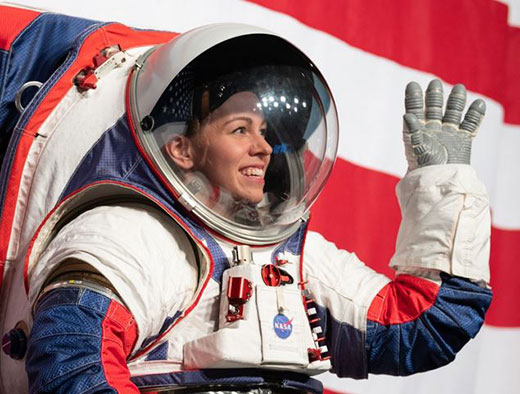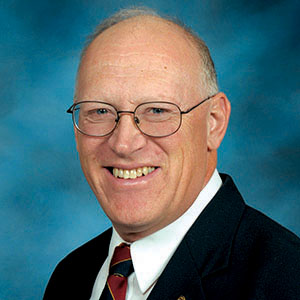
Kristine Larson Davis| Download this photo.
Kansas Profile – Now That’s Rural: Kristine Larson Davis, space engineer
September 2, 2020
By Ron Wilson, director of the Huck Boyd National Institute for Rural Development at Kansas State University.
“Shoot for the stars.” That can be inspiring advice. Today we’ll meet a young woman from rural Kansas who followed that advice - not just as a dream, but as a career. Thanks to the K-Stater magazine, the K-State Alumni Association, and writer Ashley Pauls for this story.
Kristine Larson Davis is a spacesuit engineer at NASA’s Johnson Space Center in Houston. She grew up at Galva in McPherson County. As a kid, she looked up at the stars and dreamed about exploring the universe.
Her parents would often take her to the Cosmosphere space museum in Hutchinson. That museum helped make the wonders of the universe feel just a little bit closer. In middle school, she had the opportunity to attend space camp and heard that one of the best ways to work at NASA was to become an engineer.
“I loved space and decided then I wanted to become a mechanical engineer to work for NASA one day,” Kristine said. “I carried that goal through high school and college, and it helped me get to where I am today.”
Kristine came to K-State where she earned a degree in mechanical engineering and a minor in leadership studies. She enjoyed participating in organizations such as the Society of Women Engineers and attended several of the society’s annual conferences across the country. “It was so inspiring to see so many successful women in engineering, and all the opportunities available to me,” Kristine said.
She also studied abroad at Czech Technical University her sophomore year. She said the experience opened her eyes to other cultures and really pushed her out of her comfort zone.
“I will never forget all the long hours spent in the College of Engineering Library, and mechanical engineering computer labs,” Kristine said. “I made lifelong friends during those late nights.”
While at K-State, she learned about NASA’s Pathways Program which provides an opportunity to work and explore space-related careers while still in school. Kristine did four internship rotations with Johnson Space Center and started full-time there after graduating in December 2015.
Today, Kristine Larson Davis is a spacesuit engineer at NASA, helping to prepare for the Artemis missions. The goal of the NASA Artemis program is to land the first woman and next man on the moon by 2024, eventually taking “the next giant leap,” which is sending astronauts to Mars.
Specifically, Kristine is working on elements of the pressure garment of the Exploration Extravehicular Mobility Unit which will serve as the spacesuit for the Artemis missions.
“My tasks range from project management and systems engineering, to testing hardware and understanding how well it works for our future astronauts,” Kristine said. “I love that I get to work on the Artemis spacesuit, which will enable future exploration. My favorite days are when I get to be the test subject, and experience what it is like to be in a pressurized spacesuit.”
Recently, Davis had the opportunity to lead a test series of a prototype spacesuit in the Neutral Buoyancy Lab (NBL). The NBL is an astronaut training facility and neutral buoyancy pool that helps simulate the microgravity astronauts encounter in space.
“As test lead, I had to get all the support equipment ready, work through all the paperwork and safety reviews, schedule and then execute each test,” Kristine said. “It felt great when we finished up our last NBL run, and completed a safe, successful test series.”
“I hope that after the 2024 Artemis missions, NASA continues to grow humanity’s presence in our solar system with longer-term missions on the moon and one day, a mission to Mars,” she said.
It’s exciting to see such vision from a young woman from the rural community of Galva, Kansas, population 870 people. Now, that’s rural.
For more stories, go to www.k-state.com.
Shoot for the stars. That is inspiring advice to a young person such as Kristine Larson Davis. We commend Kristine for making a difference by pursuing this remarkable career in engineering and space science. She’s even helping make a spacesuit for the stars.
Audio and text files of Kansas Profiles are available at http://www.kansasprofile.com. For more information about the Huck Boyd Institute, interested persons can visit http://www.huckboydinstitute.org.
-----------
The mission of the Huck Boyd National Institute for Rural Development is to enhance rural development by helping rural people help themselves. The Kansas Profile radio series and columns are produced with assistance from the K-State Research and Extension Department of Communications News Media Services unit. A photo of Ron Wilson is available at http://www.ksre.ksu.edu/news/sty/RonWilson.htm. Audio and text files of Kansas Profiles are available at http://www.kansasprofile.com. For more information about the Huck Boyd Institute, interested persons can visit http://www.huckboydinstitute.org.


